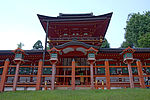| Yoshida Shrine 吉田神社 | |
|---|---|
 Yoshida torii at cherry blossom time. | |
| Religion | |
| Affiliation | Shinto |
| Deity | Takemikazuchi Himegami |
| Location | |
| Location | 8 Yoshidakaguraokacho, Sakyō, Kyoto 〒 606-8311 |
| Geographic coordinates | 35°01′31″N 135°47′05″E / 35.0253488°N 135.784631968°E |
| Architecture | |
| Style | Kasuga-zukuri |
| Date established | 859 |
Yoshida Shrine (吉田神社, Yoshida jinja) is a Shinto shrine located in Sakyō-ku in Kyoto, Japan. It was founded in 859 by the Fujiwara clan.[1]

YouTube Encyclopedic
-
1/3Views:9181 8864 688
-
節分 Setsubun at Yoshida Shrine in Kyoto - Devils vs Exorcist
-
District - Yoshida in Kyoto
-
京都・吉田神社「節分祭-古式追儺式-」2013 Yoshida-Jinja Shrine
Transcription
History
The shrine became the object of Imperial patronage during the early Heian period.[2] In 965, Emperor Murakami ordered that Imperial messengers were sent to report important events to the guardian kami of Japan. These heihaku were initially presented to 16 shrines;[3] and in 991, Emperor Ichijō added three more shrines to Murakami's list — including Yoshida.[4]
From 1871 through 1946, the Yoshida Shrine was officially designated one of the Kanpei-chūsha (官幣中社), meaning that it stood in the second rank of government supported shrines.[5] Yoshida Kanetomo, founder of Yoshida Shinto, is buried here.
See also
Notes
- ^ Kyoto University: "The Ancient Shrine Continues to Watch Over Kyoto University." Archived May 23, 2009, at the Wayback Machine
- ^ Breen, John et al. (2000). Shinto in History: Ways of the Kami, pp. 74-75.
- ^ Ponsonby-Fane, Richard. (1962). Studies in Shinto and Shrines, pp. 116-117.
- ^ Ponsonby-Fane, Shrines, p. 118.
- ^ Ponsonby-Fane, Richard. (1959). The Imperial House of Japan, pp. 126.
References
- Breen, John and Mark Teeuwen. (2000). Shinto in History: Ways of the Kami. Honolulu: University of Hawaii Press. ISBN 978-0-8248-2363-4
- Ponsonby-Fane, Richard. (1962). Studies in Shinto and Shrines. Kyoto: Ponsonby Memorial Society. OCLC 399449
- ____________. (1959). The Imperial House of Japan. Kyoto: Ponsonby Memorial Society. OCLC 194887


